|

by
John DeSalvo
extracted from Pyramid SourceBook
The Surroundings
The Great Pyramid of Giza was originally covered with beautiful
polished limestone, known as casing stone. The ancient writer Strabo
is quoted as saying,
“It seemed like a building let down from
heaven, untouched by human hands.”
It has been calculated that the
original pyramid with its casing stones would have acted like a
gigantic mirror and reflect light so powerful that it would be
visible from the moon as a shining star on earth.
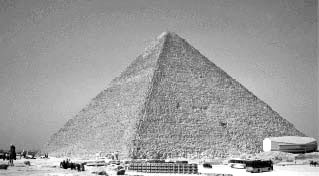
The Great Pyramid of Giza is the only remaining and oldest of the 7
wonders of the ancient world. It stands majestically on the northern
edge of the one square mile Giza Plateau. It is 10 miles west of
Cairo on the eastern extremity of the Libyan section of the Sahara
Desert on the west bank of the Nile.
It is composed of over 2 ½ million blocks of limestone, which weigh
from two to seventy tons each. (Recent quarry evidence indicates
that there may only be about 750,000 blocks and which weigh between
½ to 2 tons). Its base covers over 13 acres (each side covers about
5 acres) and its volume is approximately 90 million cubic feet. You
could build over 30 Empire State buildings with its masonry. It is
about 454 feet high (originally rose to a height of 484 feet) which
is equivalent to a modern 50-story building.
There are currently 203
courses or steps to its summit and each of the four triangular sides
slope upward at an angle of about 52 degrees (more precise 51
degrees 51 minutes 14.3 seconds). The joints between adjacent blocks
fit together with optical precision and less than 1/50 of an inch
separates individual blocks. The cement that was used is extremely
fine and strong and defies chemical analysis. It also appears that
if pressure is applied, the blocks will break before the cemented
joints. Today, with all our modern science and engineering,
we would
not be able to build a Great Pyramid of Giza.
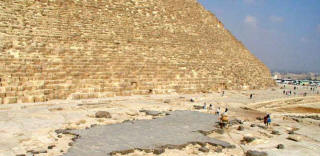
East side of the Great Pyramid
James Ferguson, in his great work, the
History of Architecture,
describes the Great Pyramid as,
“the most perfect and gigantic
specimen of masonry that the world has yet seen. No one can possibly
examine the interior of the Great Pyramid without being struck with
astonishment at the wonderful mechanical skill displayed in its
construction.”
The pyramid is oriented to true north with a greater accuracy than
any known monument, astronomical site, or any other building in the
world. Today, the most accurate north oriented structure is the
Paris observatory which is 6 minutes of a degree off true north. The
Great Pyramid of Giza is only 3 minutes of a degree off true north.
Studies have shown that these 3 minutes off true north may be due to
either a shift in the earth’s pole or movement of the African
continent. Thus, when first built, it may have been perfectly
oriented to true north.
Most academic Egyptologists claim that The Great Pyramid was
constructed around 2550 BC, during the reign of Khufu (known to the
Greeks as Cheops) in the 4th Dynasty (2575-2465 B.C.)
The only known statue or representation of Khufu to exist is a small
3” ivory statue pictured below.
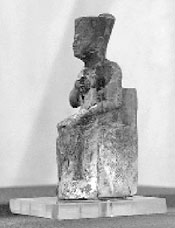
A small ivory figure of the Pharaoh Khufu
in the Cairo Museum
Others researchers question this date since erosion studies on the
Giza plateau indicate that the Great Pyramid is much older. In fact,
some researchers have proposed that it may be thousands of years
older than the currently accepted date. See Articles
B and
D. Either
way, it was the most magnificent structure in the ancient world.
It is observed that there is a huge difference between the Great
Pyramid and any of the other ancient pyramids in Egypt. The
Great
Pyramid has such a far superior elaborate interior structure and the
workmanship is also far above any of the other pyramids. It does not
seem to fit in with the other pyramids at all and appears to have
come out of nowhere.
It is unfortunate that a great degree of damage has been done to the
Great Pyramid by man. Besides the casing stones being stripped in
the 14th century by the Arabs to build Mosques and other buildings,
explorers have left their marks also. Colonel Vyse, in his
explorations in the 1800’s, used blasting with gunpowder to try to
find hidden entrances and chambers. A huge and ugly 30-foot scar
that he produced in his attempt to find a hidden entrance on the
south side of the Great Pyramid can be seen very visibly today

Damage on the south side
caused by Colonel Vyse
Next to the Great Pyramid stand two additional large pyramids.
Academic Egyptologists attribute the slightly smaller one (471 feet
high) to Khufu’s son and successor, Chephren (Khafra). It still has
its upper casing stones intact. The other, much smaller (213 feet
high), sheathed in red granite, is traditionally attributed to
Chephren’s successor, the grandson of Khufu, Mykerinus (Menkaura).
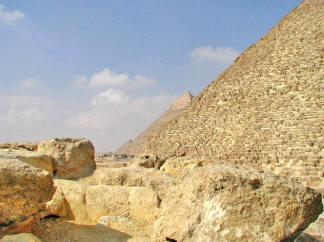
The Three Giza Pyramids
with the South Eastern corner of the Great
Pyramid in the foreground
It may appear that the 2nd pyramid (Chephren’s) is larger than the
Great Pyramid. Chephren’s pyramid is 471 feet high. The Great
Pyramid originally with its capstone would have been 484 feet high.
So, in its original state it would have been about 13 feet higher
than Chephren’s Pyramid. But, the Great Pyramid is missing its
capstone, which currently makes it 454 feet high and smaller than Chephen’s (since the capstone would have added about 30 feet to its
height).
Also, Chephren’s pyramid is on higher ground; about 30 feet higher
than the ground on which the Great Pyramid was built.
The debate goes on concerning who built these pyramids, and, when
and how they were built. The total number of identifiable pyramids
in Egypt is about 100, all of which are built on the west side of
the Nile.
In addition to the 3 main Giza pyramids, there are an additional 7
smaller or subsidiary ones on the Giza Plateau that are attributed
by academic Egyptologists to Khufu’s family members.

Map of the Giza Plateau
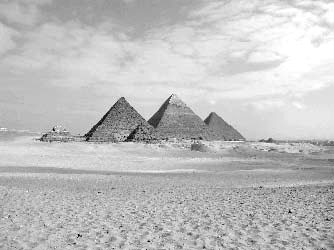
Chephren’s pyramid in the Middle with casing
stones at the top
A very prominent and well-known feature on the
Giza Plateau is the
famous
Sphinx. Attributed to the Pharaoh Kephren, there is much
debate about its age. The Sphinx lies about 1200 feet southeast of
the Great Pyramid and is a magnificent site to behold. It was carved
from the sandstone hill and is about 240 feet long, 66 feet high,
and about 13 feet wide. It is thought that originally it was painted
in many different colors.

The four faces of the pyramid are slightly concave, which is not
apparent to the naked eye. Sir Flinders Petrie noted this hollowing
on each face of the pyramid and it was as much as 37 inches on the
northern face. This effect is only visible from the air and under
certain lighting conditions and lines of sight. Because of this
hollowing, a shadow appears at dawn and sunset on the equinoxes on
the southern face of the Great Pyramid. But remember, the finished
pyramid was covered with casing stones and this effect would not be
produced. No one knows why this precision indentation was built into
each side knowing that the pyramid would be finally covered with
casing stones. It is very interesting that Petrie found no evidence
of this hollowing on the lower casing stones that were still intact.
While looking up at the Great Pyramid, you may be tempted to climb
it right up to the summit. It is a long and hard climb and would
take about an hour with several stops to rest on the way. Many
tourists in the past have, but today, guards will try to prevent you
since some have fallen to their death in this pursuit.
When you look up at the Great Pyramid it is flat topped and not
pointed like a pyramid should be. Its apex or capstone seems to be
missing. The capstone would have made the pyramid about 30 feet
higher (from the 454 feet as it currently is now to 484 feet high).
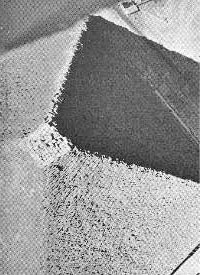
Arial photograph – east side in shade
In 1874, a large steel mast was erected on the top of the summit by
two astronomers, David Gill and Professor Watson, to mark the
position of the apex if the pyramid would have been completed. This
mast is still present.

Usually, when a pyramid was constructed, the top part or capstone
was the last thing to be placed on it. The remains of a ‘pyramidion’
was discovered on the Giza plateau in the 1980’s. It probably
belonged to a small satellite pyramid.
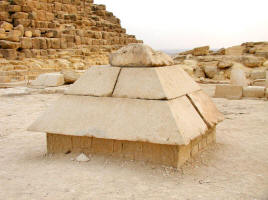
‘Pyramidion’ discovered at Giza
The capstone was considered the most important part of the pyramid
and was made of special stone or even gold and also highly
decorated. Capstones from other pyramids have been found and one is
shown below.

The Pyramidion of the Pharaoh Amenemhat III.
12th Dynasty
Whether the Great Pyramid was intentionally built without a
capstone, or never was finished, or it was stolen or destroyed is
unknown. But the accounts of visitors to the pyramid from the
ancient past (as far back as the time of Christ) always reported
that the pyramid lacked a capstone.
One of the earliest references to the missing capstone is from the
writings of Diodorus Siculus in 60 BC. He tells us that in his day,
when the Pyramid stood with its casing stones intact, the structure
was “complete and without the least decay, and yet it lacked its
apex stone”.
Capstones made of gold or other valuable metals were probably the
first things looted. A problem with this possibility is that this
would be a very large capstone and hard to remove. If you climbed to
the top, you could walk around very freely on the pyramid as many
have done. It is about 20 feet in each direction. Thus, this
capstone would have been huge and weighed a tremendous amount. No
one has been able to explain why the Great Pyramid would have been
built without a capstone if indeed it were.
Many tourists have climbed to the top of the Great Pyramid. One such
person was Sir Siemen’s, a British inventor who climbed to the top
with his Arab guides during the end of the 19th century. One of his
guides called attention to the fact that when he raised his hand
with fingers spread apart, he would hear a ringing noise. Siemen
raised his index finger and felt a prickling sensation. He also
received an electric shock when he tried to drink from a bottle of
wine. Being a scientist, Siemen then moistened a newspaper and
wrapped it around the wine bottle to convert it into a Leyden jar
(an early form of a capacitor). When he held it above his head, it
became charged with electricity. Sparks were then emitted from the
bottle. One of the Arab guides got frightened and thought Siemen was
up to some witchcraft and attempted to seize Siemen’s companion.
When Siemen’s noticed this, he pointed the bottle towards the Arab
and gave him such a shock that it knocked the Arab to the ground
almost rendering him unconscious.
It’s safe to say that men have been seeking an answer to the riddle
of the Great Pyramid for over 4000 years. Theories range from a tomb
or monument for a Pharaoh, an astronomical observatory, a place for
elaborate Egyptian rituals, a giant sundial, a grain storage
structure, a prophetic monument, a water irrigation system, a
repository for ancient knowledge, the Egyptian Book of the Dead
immortalized in stone, a communication device to other worlds or
realms, etc. The list goes on. Also the list of who build the Great
Pyramid includes the Egyptians, descendents of Seth, people from
legendary Atlantis, and extraterrestrials to name a few.
What makes the Great Pyramid of Giza so unique is that it is the
only known pyramid to have a magnificent internal system. Before the
Great Pyramid came into existence its peculiar internal construction
was unknown; after it no attempt was made to repeat it. It appears
that the pyramids that came after it were a poor imitation and did
not approach its magnificence. If the Great Pyramid was originally
built as a tomb, why take the time and trouble to construct such a
precision structure.
To quote Marsham Adams, the Oxford scholar “It is absolutely unique.
No other building contains any structure bearing the least
resemblance to the upper chambers."
H.E. Licks, mathematician states: “So mighty is the Great Pyramid at Gizeh and so solidly is it constructed that it will undoubtedly
remain standing long after all other buildings now on Earth have
disappeared.”

Philo of Byzantium compiled the list of the 7 wonders of the ancient
world in the 2nd century B.C. The Great Pyramid of Giza was named as
the first wonder of the ancient world and the only one still
remaining to this day.
The other wonders are:
-
The Colossus of
Rhodes
-
The Statue of Zeus at Olympia
-
The Mausoleum at Halicarnassus
-
The Hanging Gardens of Babylon
-
The Temple of Artemis
(Diana) at Ephesus
-
The Light house of Alexandria
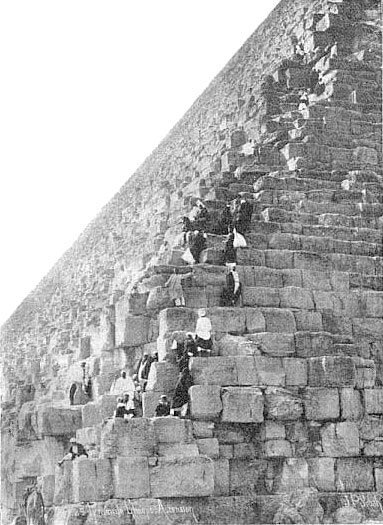
Tourists climbing the Great Pyramid in the early 1900’s
Originally, the pyramid was completely covered with smooth, highly
polished limestone blocks known as casing stones. These stones came
from the quarries of Tura and Masara in the Moqattam Hills on the
opposite side of the Nile. These casing stones reflected the sun’s
light and made the pyramid shine like a jewel. The ancient Egyptians
called the Great Pyramid “Ikhet”, meaning the “Glorious Light”. At
the present, only a few of these are left in position on each side
at the base.
The Arabs stripped off most of them in the 14th century
after an earthquake loosened many. They cut them up to build mosques
and buildings in Cairo. One of the largest remaining casing stones
is nearly 5 feet high by 8 feet and weighs about 15 tons. How these
blocks were transported and assembled remains a mystery. To
manufacture just two blocks with a tolerance of .010 inch and place
them together with a gap of no more than .020 inch is a remarkable
feat. The Great Pyramid had at one time over 100,000 similar casing
stones.
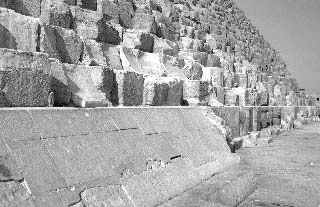
Casing Stones
Herodotus, the Greek historian of the fifth century BC, regarded as
the father of history wrote the earliest description in existence of
the
pyramids. When Herodotus visited the pyramids in 440 B.C., it was as
old to him as his period is to us. He wrote that each of the
pyramid’s four faces were still covered with highly polished
limestone (casing stone). Also the joints were so fine that they
could hardly be seen.
The ancient writer Strabo said “It seemed like a building let down
from heaven, untouched by human hands.”
It has been calculated that the original pyramid with its casing
stones would act like gigantic mirrors and reflect light so powerful
that it would be visible from the moon as a shining star on earth.

Casing Stones still remaining at the base of the north end of the
Pyramid
Colonel Howard Vyse who, in 1837, at the expense of a large fortune,
and after seven months of work, with over a hundred assistants,
brought the Great Pyramid within the sphere of modern scientific
investigation. He rediscovered the corner-sockets previously
uncovered by the French in 1799. When Vyse decided to clear away
some debris by the pyramid, he discovered two of the original
polished limestone casing stones.
Christopher Dunn, one of our Research Directors, has said the
following about the casing stones in his book “The Giza Power
Plant”.
The records show that the outer casing blocks were square and flat,
with a mean variation of 1/100 inch over an area of thirty-five
square feet. Fitted together, the blocks maintained a gap of 0 to
1/50 inch, which might be compared with the thickness of a
fingernail. Inside this gap was cement that bonded the limestone so
firmly that the strength of the joint was greater than the limestone
itself. Here was a prehistoric monument that was constructed with
such precision that you could not find a comparable modern building.
More remarkable to me was that the builders eventually found it
necessary to maintain a standard of precision that can be found
today in machine shops, but certainly not on building sites.
Interior Features

From the diagram you can see that there are two systems of passages,
a downward or descending system and an upward or ascending system.
The entry into the pyramid is on the north side, which is about 56
feet above ground level. The passages are all in the same vertical
plane, parallel to the north-south axis of the pyramid. They are not
in the direct center of the pyramid but off 24 feet to the east of
center. Thus the entrance to the pyramid is not in the centerline of
the north side, but to the east of it by 24 feet. Also all chambers
extend westward from the vertical plane of the passage system, and
none extend eastward.
In 830 AD, under caliph Abdullah Al Mamoun, the Arabs searched for a
secret entrance into the pyramid but could not find one. His workman
than tried to burrow straight into the solid rock of the pyramid in
hope of running across a passage. They tunneled into the solid core
of the pyramid for over 100 feet and were about to give up but they
heard the sound of something falling to the east of the tunnel. They
altered their tunneling toward the direction of the sound and
eventually broke into the descending passage. The workers stated
that it was “exceeding dark, dreadful to look at, and difficult to
pass.”
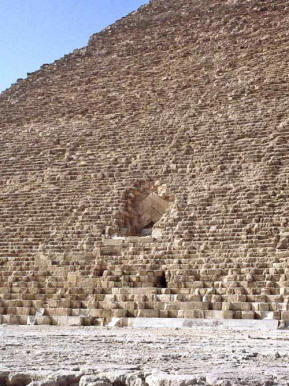
The original entrance (center and with angle blocks over the top)
and Al Mamoun’s forced cavity (below and to the right)
The original entrance leads into the descending passage, which
slopes down at an angle of about 26 degrees and measures 3 1/2 feet
wide by almost 4 feet high. The distance of this passage to the
beginning of the horizontal subterranean chamber passage is 344
feet.
Strabo, a geographer, visited the pyramids in 24 BC. He describes an
entrance on the north face of the pyramid made of a hinged stone
which could be raised but which was indistinguishable from the
surrounding stone when closed. The location of this moveable door
was lost during the 1st Century AD.
Many researchers do think that the Great Pyramid was built with a
swivel door at its entrance. It would have weighed about 20 tons and
balanced so it could be opened by pushing on it from the inside.
When closed it would form a perfect fit that could not be detected.
Swivel doors have been found in two other pyramids; those built by
Sneferu and Huni.
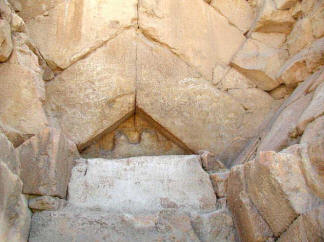
Limestone gables over the original entrance to the Pyramid.
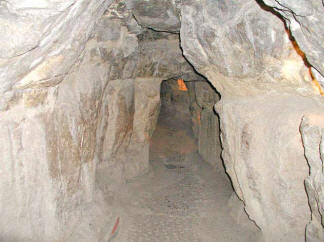
Entrance to Al Mamoun’s forced passage on the North side made
in 820 AD
About 40 feet down from the original entrance, there appears to be
scored lines running along both sides of the descending passageway.
Some have suggested it is almost like that is a start point in the
Great Pyramid. The scored lines are of high precision and the
purpose of significance of these lines remains a mystery. In the
ceiling 97 feet down the descending passage is a granite plug, which
blocks the entrance to the ascending passage. It is made of very
hard quartz, mica and feldspar. There are 3 granite plugs side by
side.
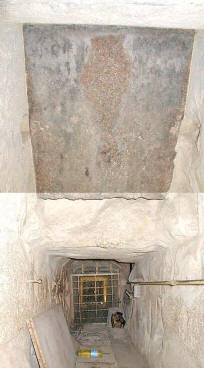
The Granite Plug which blocks the entrance to
the Ascending Passage
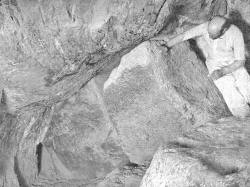
The upper south end of the Granite plugs
showing two of the three
blocking stones
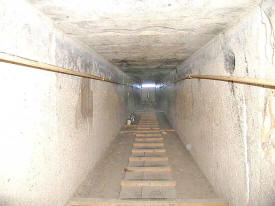
Descending passage
Al Mamoun’s men dug around these plugs through the softer limestone
to gain entrance into the ascending passage. Once clear of the
plugs, they forced their way into the ascending passage. They went
up the ascending passage and found themselves in the Grand Gallery,
and from there explored the Queen’s Chamber and the King’s Chamber.
The men searched everywhere for treasure but the only thing they
found was a large lidless coffin of highly polished granite.
To
appease his men, Al Mamum secretly hid an amount of gold in the
pyramid that equaled the just wages of his men. He explained this
coincidence on the great wisdom of Allah. An interesting Arab legend
says that in this coffin they found a stone statue with sword,
breastplate of gold with precious gems, and a large ruby on the
head, which gave off light. Also the statue was inscribed with a
strange writing no one could translate.
Once past these granite plugs we are in the ascending passage. The
ascending passage slopes up at a 26-degree angle (same angle as the
descending passage slopes down) and has the same dimensions as the
descending passage (4 feet high by 3 1/2 feet wide).
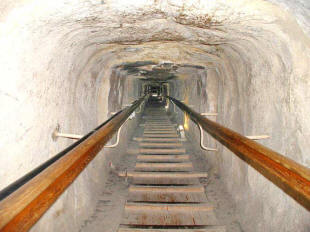
The First Ascending Passage - Looking South (up)
Following the ascending passage for 124 feet, we finally arrive at a
large open space known as the Grand Gallery. At this point of
intersection, you can take one of two routes. You can continue going
up the grand gallery and eventually end up in the King’s chamber or
continue in a horizontal direction through another passage (127 feet
long) and wind up in the Queen’s chamber.
We will first continue up
the Grand Gallery to the King’s Chamber. Also at this intersection
(where the ascending passage meets with the grand gallery) is a hole
that leads to a shaft (known as the well shaft), which connects,
with the descending passage below. This near vertical tunnel is
about 3 feet in diameter.

Junction of Grand Gallery (above)
and Queen’s Chamber Passage (below
and running horizontal)
The Well Mouth is in the northwest corner of the Grand Gallery. This
view is from the south showing the upper end of the ascending
passageway (right). Also part of the floor of the horizontal
passageway to the Queen’s Chamber is in the foreground.

The Grand Gallery is a hall 153 feet long and 7 feet wide at the
floor level and about 28 feet high. It continues upward at the same
slope as the ascending passage. The walls rise in seven courses of
polished limestone each corbelled 3 inches toward the center, making
the gallery narrow from 62 inches at the base to 41 inches at the
top. The first corbelling is 7 feet high.

The Grand Gallery - North end
On both sides of the central two-foot passage are two narrow ramps,
18 inches wide and slotted at regular intervals. The purpose of
these ramps and slots is unknown.
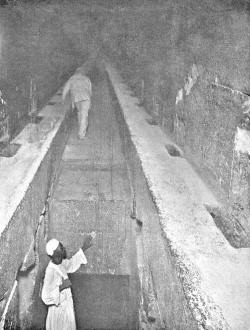
Grand Gallery looking south
showing the two ramps and the slots
The next photo shows the north end of the Grand Gallery showing six
of the seven overlappings of the side wall. Also at the base of the
north wall is the upper half of the doorway of the ascending
passageway.

At the top of the Grand Gallery lies a huge stone step, which
measures 6 feet wide by 3 feet high. It forms a platform 8 feet
deep, which is very worn and chipped, and has been referred to as
the “Great Step”.

The Great Step at the top of the Grand Gallery
Past the Great Step is another low, horizontal passage 41 inches
square, which leads to the King’s Chamber. A third of a way along
this passage, it rises and widens into a sort of antechamber, the
south, east, and west walls of this passage are no longer limestone
but red granite.

King’s Chamber Passage from front of the Great Step
So, at the top of the Great Step, you need to bow down to enter the
low square passage, which is only 3 ½ feet high to enter the
antechamber. After going forward about 4 feet, you enter the
antechamber and can stand up in a little compartment measuring 21
inches from front to back and by 42 inches from side to side.
A
suspended stone slab, also known as the “Granite Leaf”, appears in
front of you. It is nearly 16 inches thick and composed of two
blocks, which are on top of each other. They are fitted into grooves
in the wall. This slab only descends no further than the level of
the roof of the entrance passageway so you need to duck under this
slab to continue.
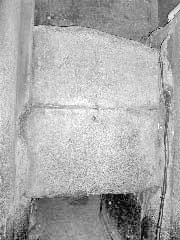
Granite Leaf

The south side of the Granite Leaf
in the Antechamber

Vertical section showing King’s Chamber,
Antechamber, and South end
of Grand Gallery
Once you exit the antechamber, you enter another low passage that
continues for about 8 feet until you enter the King’s Chamber.

King’s Chamber
Entrance door
The King’s Chamber and Above
The King’s Chamber is entirely constructed out of granite and its
dimensions are approximately 34 feet by 17 feet and 19 feet high.
There are exactly 100 blocks making up the walls of the King’s
Chamber. The granite used is red granite (composed of granules of
quartz, feldspar, mica) and comes from the quarries at Aswan (Syene),
which is about 500 miles from Giza. The roof is formed of enormous
granite beams and one of the largest weighs about 70 tons and is 27
x 5 x 7 feet.
The Coffer, located in the King’s Chamber,
is the only artifact known to be found in the Great Pyramid. It
is a lidless box cut from a solid block of granite that measures 6
feet 6 inches long, 2 feet 3 inches wide, and 3 feet deep. It may
have once had a sliding lid since there is a ridge along the top
edge of the coffer. The coffer is chipped at one corner. It’s
granite is harder than the granite which makes up the walls of the
King’s Chamber.
This box has been called many names. It is usually referred to as
the Coffer and has also been called a Coffin, a Sarcophagus, The
Granite Box, The Empty Stone Chest, etc. It is currently located a
few meters away from the west wall of the chamber but many think it
was originally located in the center of the chamber. Also, since it
is too large to pass through the low passages leading into the King,
it must have been placed in the chamber before the chamber was
closed and passages sealed.
Many people who have visited and studied the Great Pyramid feel that
the King’s Chamber is the most sacred place in the pyramid. It is
reported that strange phenomena happens there. Researchers who rule
out that the Great Pyramid was built as a tomb also rule out that
this box was used as a coffin. Thus, they prefer the name coffer to
sarcophagus or coffin and its function is not known. People who
spend time in the King’s Chamber alone feel inclined to lie in the
coffer. Many strange experiences have been reported. Paul Brunton
reports a very interesting experience in his book A Search in Secret
Egypt, 1936. I personally have friends and fellow researchers who
shared with me their strange experiences when left alone in the
King’s Chamber and laid down in the coffer. Many interesting things
have been reported about the coffer since the 17th century.
In 1646, John Greaves described the coffer in the first scientific
publication on the Great Pyramid.
Here is an excerpt
from him about the coffer. The “Room” he refers to is the King’s
Chamber and the “Monument” is the Coffer.
“Within this glorious Room (for so I may justly call it), as within
some consecrated Oratory, stands the Monument of Cheops, or Chemmis,
of one piece of Marble, hollow within and uncovered at the top, and
sounding like a Bell. … This monument, in respect of the nature and
quality of the Stone, is the same with which the whole Room is
lined; as by breaking a little fragment of it, I plainly discovered,
being a speckled kind of Marble, with black, and white, and red
Spots, as it were equally mix’d, which some Writers call The baick
Marble.”
In 1715, a Roman Catholic, Pere Claude Sicard visited the Great
Pyramid. His account is interesting in that he describes an unusual
feature of the empty coffin in the King’s chamber. He states:
“It was formed out of a single block of granite, had no cover, and
when struck, sounded like a bell.”
Others have also reported about this strange melodic sound that the
coffin emits when struck.
In 1753, Abbe Claude-Louis Fourmont visited the Great Pyramid and
also noted the sonorous coffin did not have any inscriptions on it.
The French invaded Egypt in 1798 and there was a large battle at
Embaba, located about 10 miles from the Great Pyramid. Historians
refer to this as “The Battle of the Pyramids.” General Napoleon
addressing his troops before the big battle said:
“Soldiers, from the height of these pyramids forty centuries are
watching us”.
Napoleon was victorious and once while sitting at the base of the
pyramid, he had calculated that there was enough stone in all 3 of
the Giza pyramids to build a 10 feet high, 1 foot thick, wall around
France.
There is an interesting story about Napoleon on his visit to the
great pyramid. He asked to be left alone in the King’s chamber.
When
he emerged, it was reported that he looked visibly shaken. When an
aide asked him if he had witnessed anything mysterious, he replied
that he had no comment, and that he never wanted the incident
mentioned again. Years later, when he was on his deathbed, a close
friend asked him what really happened in the King’s chamber. He was
about to tell him and stopped.
Then he shook his head and said,
“No,
what’s the use. You’d never believe me.”
As far as we know, he never
told anyone and took the secret to his grave. (It is interesting to
note that there is an unsubstantiated story that Napoleon had hinted
that he was given some vision of his destiny during his stay in the
King’s Chamber).
Alexander the Great also spent time alone in the
King’s Chamber like many famous people throughout history.
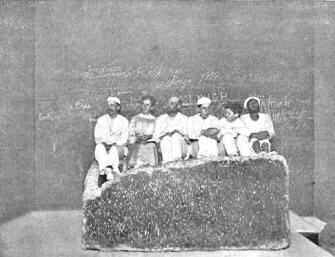
Afternoon Tea in the King’s Chamber

King’s Chamber - West End with Coffer
This beautiful granite shaped box made was made from a solid block
of chocolate-colored granite and is even harder than the granite
walls
of the King’s Chamber. The material is actually called red Granite
and seems to be a little darker and harder than the granite that
makes up the walls, floor, and ceilings of the King’s Chamber.
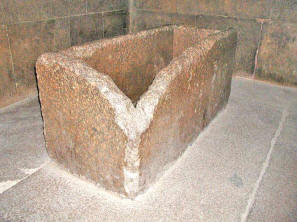

close up of the coffer
Ancient legend says that it came from Atlantis or even from
America.
It was never inscribed or decorated. The volume of the Coffer is
equal to that of the Ark of the Covenant. Did it once house the Ark?
Petrie, in his 1880 exploration of the pyramid, thought that the
coffer had been fashioned using jewel tipped saws and drills. In
fact he said “Truth to tell, modern drill cores cannot hold a candle
to the Egyptians.” Was he hinting at an unknown technology that the
Egyptians had at their disposal?
In the King’s chamber on opposite ends of the north and south walls,
are openings called airshafts. These shafts, about 9 inches square
extend over 200 feet and exit to the outside of the pyramid. The
purpose of these shafts remains a mystery but one possibility is to
bring fresh air into the King’s Chamber. John Greaves, in his 1638
visit, thought these openings were receptacles for lamps.
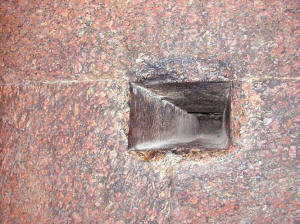
Northern Airshaft in King’s Chamber
There is an interesting story associated with the discovery of these
shafts. After Vyse found these openings in the King’s chamber, he
wanted to find out if they lead to the outside. One of Colonel
Vyse’s assistants, Mr. Hill, climbed up on the outer surface of the
pyramid and found similar openings where the airshafts exited to the
outside. A man named, Perring, one of Colonel Vyse’s engineers was
in the King’s Chamber at the time. Hill, at the outside of the
airshaft, by accident dislodged a stone which came down the 200 feet
long airshaft at high speed and came crashing through, almost
killing Perring.
When the airshafts were cleaned and opened, cool air immediately
entered the King’s Chamber. Since that time, the King’s Chamber has
always maintained a constant comfortable temperature of 68º F.,
no matter what the outside temperature was. This seems to be one of
the earliest forms of air conditioning.
Vyse also discovered a flat iron plate, 12’ by 4’ and 1/8’ thick.
This plate was removed from a joint in the masonry at the place
where the southern airshaft of the king’s chamber exits to the
outside. Experts conclude that it was left in the joint during the
building of the pyramid and could not have been inserted afterwards.
This is highly significant since the date for the Iron Age in Egypt
is around 650 BC and the traditionally accepted date for the
building of the pyramid is 2500 BC.
When Al Mamoun broke into the pyramid in the 9th century, he ordered
his men to break through the floor in the King’s Chamber close to
the coffer to look for hidden passageways. He also dug a small hole
under the coffer itself. Vyse had his workers enlarge the excavation
of the hole made my Al Mamoun. He also found nothing.
Above the roof of the King’s Chamber are found a series of 5
cavities or chambers. These have been labeled “relieving chambers”
by Egyptologists since they think that
the purpose of these spaces
is to prevent the collapse of the King’s Chamber from the tremendous
weight of the masonry above the chamber area which amounts to
several million tons. This reason has been recently questioned and
the purpose of these chambers is still being debated.
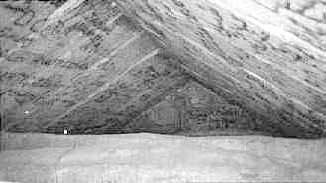
Campbell’s Chamber
The upper most relieving chamber

Lady Arbuthnot's
Chamber

Nelson's Chamber
Nathaniel Davison, British Consul at Algiers in 1763, discovered the
lowest relieving chamber. The story is that at the top of the Grand
Gallery, he noticed that his voice was echoed in a strange way and
seemed to resonate from above him. Davison tied a candle at the end
of two long canes, raised it up, and noticed at the top of the Grand
Gallery a small rectangular hole about 2 feet wide. He put 7 ladders
together to climb to the top. He found 16 inches of bat dung in this
2-foot hole that had accumulated throughout the centuries. Davison
put a kerchief over his face and made his way into the hole. After
crawling 25 feet, he reached a chamber about 3 feet high but as wide
and as long as the Kings chamber beneath.
He observed that the floor
consisted of the tops of 9 rough granite slabs each weighing up as
much as 70 tons. The ceiling of the King’s Chamber was formed by the
under sides of these blocks. He also noticed the ceiling of this
chamber was also constructed of a similar row of granite blocks.
This is as far as he went. This chamber referred to as “Davison’s
Chamber” was named after him. His measurements also confirmed the
fact that the pyramid was constructed so that its sides faced the
cardinal points of a compass.
Vyse also discovered four other chambers above Davison’s Chamber. It
was while exploring these chambers that Colonel Vyse came across the
cartouches of Khufu and his brother Khafra, as co-regent with him,
in the form of mason’s marks, painted in red ochre on the ceiling
beams. Many research have questioned this discovery in recent years.
From studying the diary of Vyse and careful analysis of the
hieroglyphics, some have accused Vyse of painting the cartouches
himself in order to be known as the person who proved Khufu built
the Great Pyramid.
The story about how Colonel Vyse discovered the other chambers above
Davison’s Chamber is very interesting. Vyse found a crack in the
ceiling in Davison’s chamber so he decided to run a reed through
this crack. It went for about 3 feet before it stopped. Thus they
suspected another chamber above Davison’s. They tried to chisel
through the granite overhead but it was too hard. Special quarrymen
were brought in and they could not even break through the hard
granite. Colonel Vyse found a man who was called Daued. He lived
mainly on hashish and alcohol.
Daued used gunpowder to blast his way
into the upper chamber. This was very dangerous since the blasted
granite flew like shrapnel. This was successful and Vyse had
discovered another chamber above Davison’s which he named
Wellington’s chamber. Three other chambers above these two were
discovered making a total of 5 chambers above the King’s Chamber.
(from lowest to highest
-Davison’s, Wellington’s, Nelson’s, Lady Arbuthnot’s, and Campbell’s
Chambers). Vyse named these chambers in honor of dignitaries. This
excavation took him almost 4 months to complete. Vyse published his
work in 1837 under the title “Operations Carried on at the Pyramid
of Gizeh”.
In 1817, an Italian named Captain Caviglia was seized by the mystery
of the Great Pyramid and decided to give up the sea and explore the
pyramid. Believe it or not, Caviglia cleaned out the bat dung from
Davison’s Chamber and turned it into an apartment in which he
resided.

Relieving Chambers
continue
→
|












































